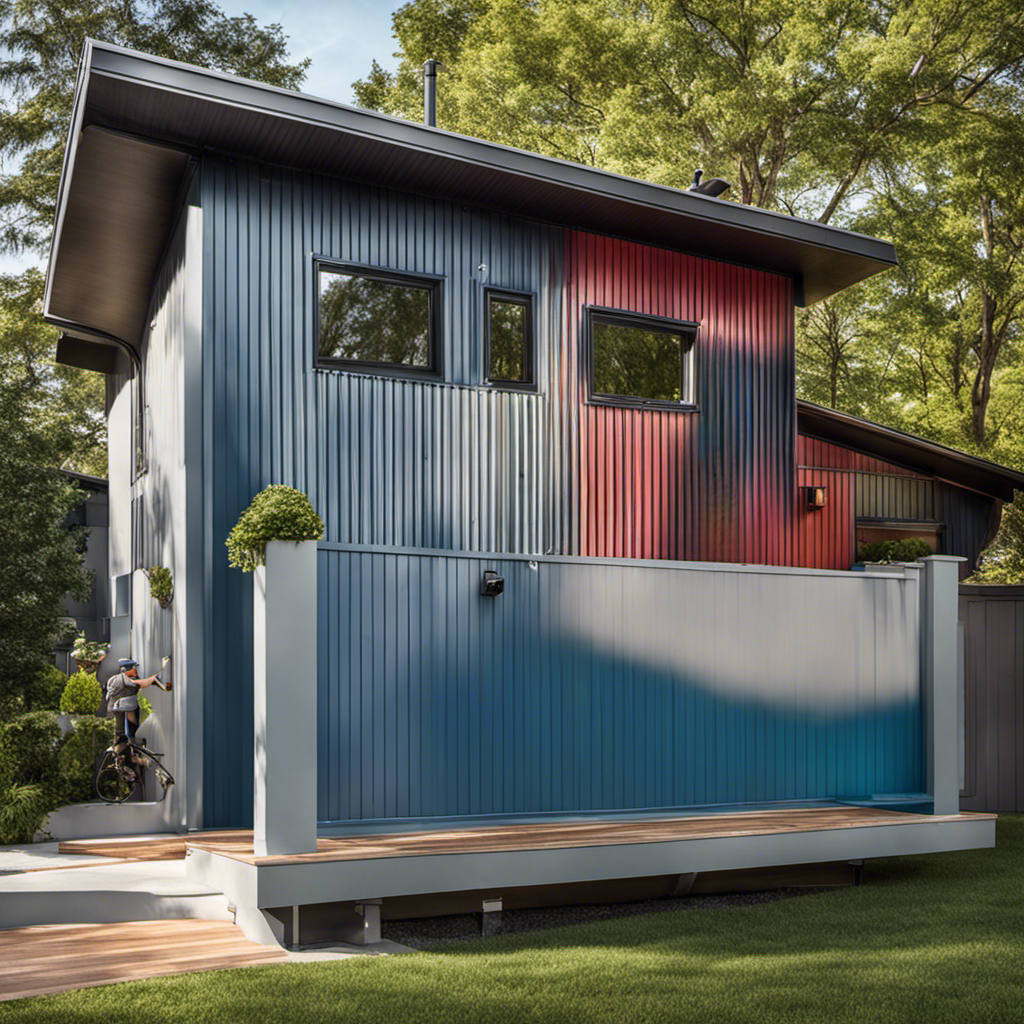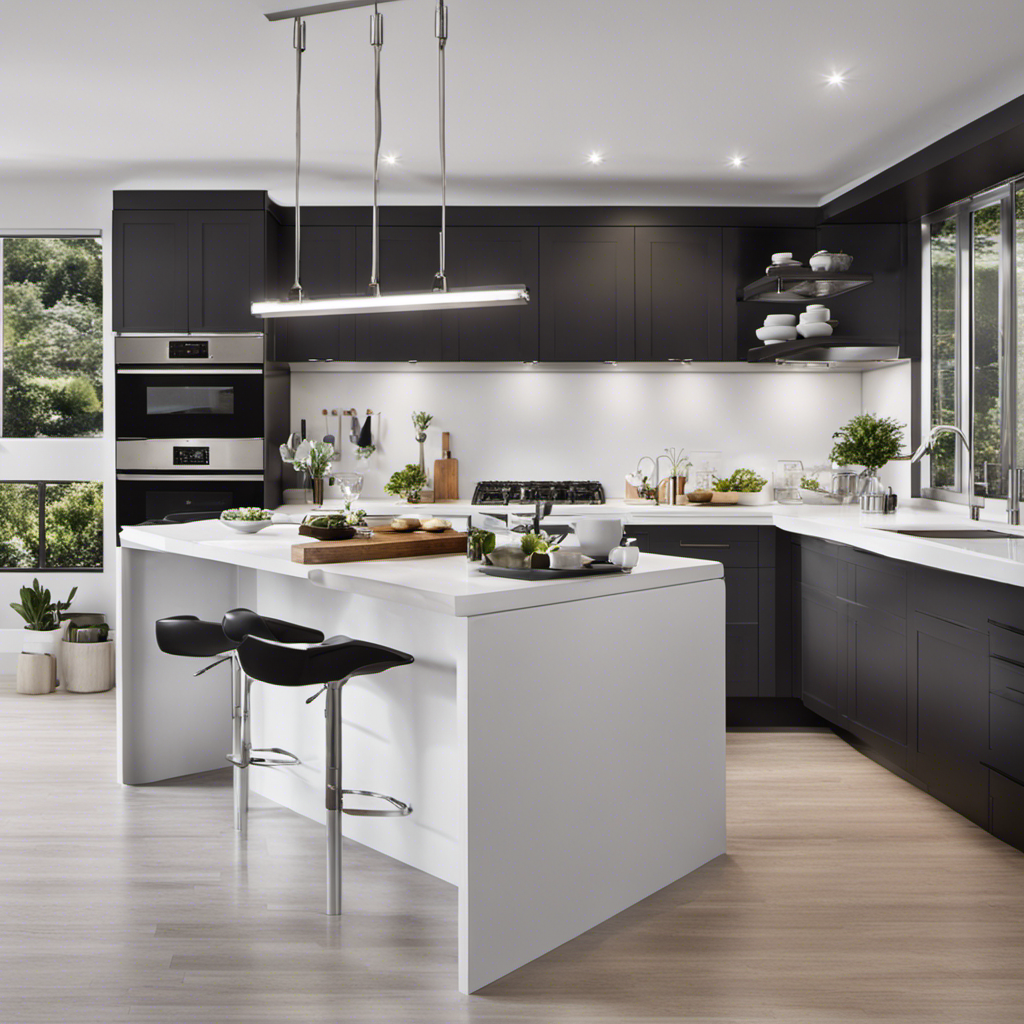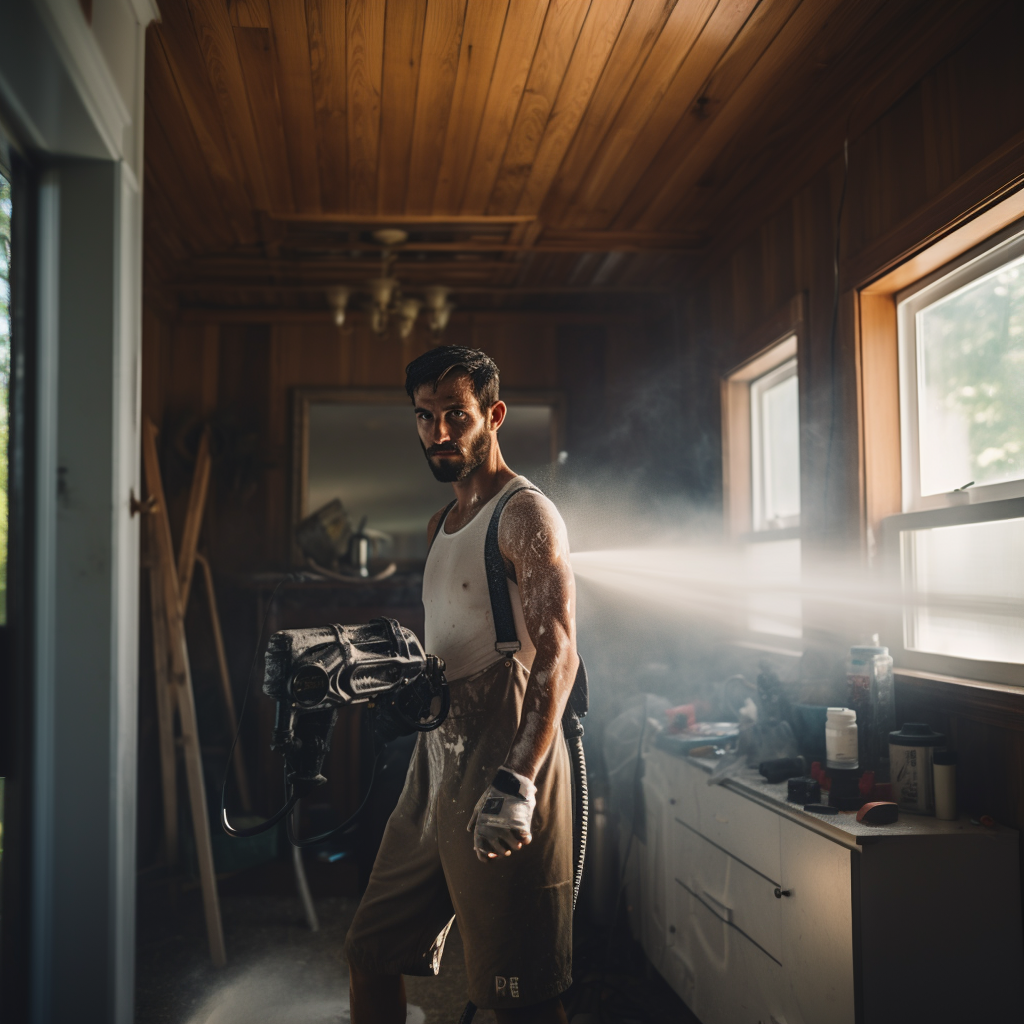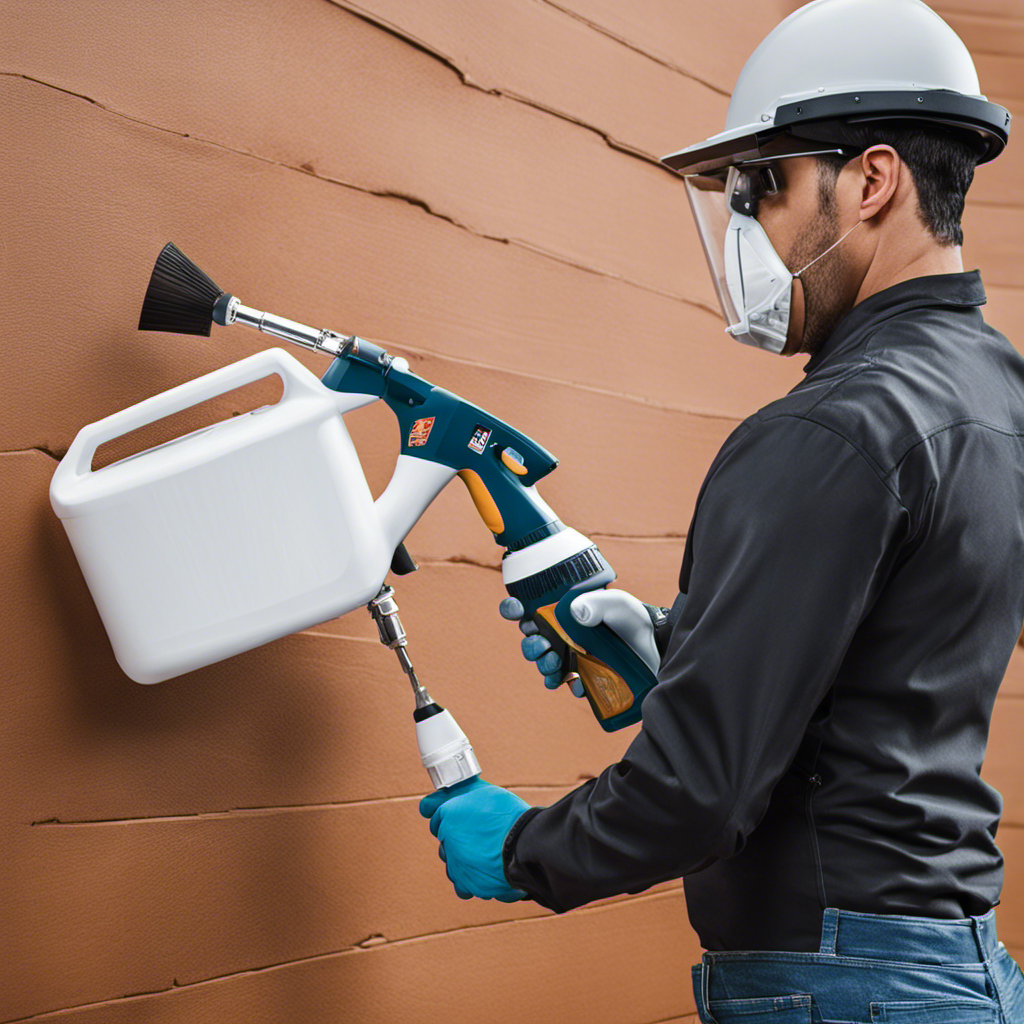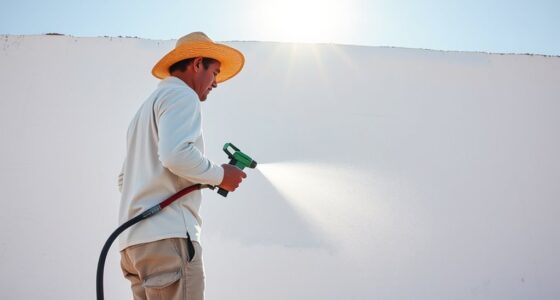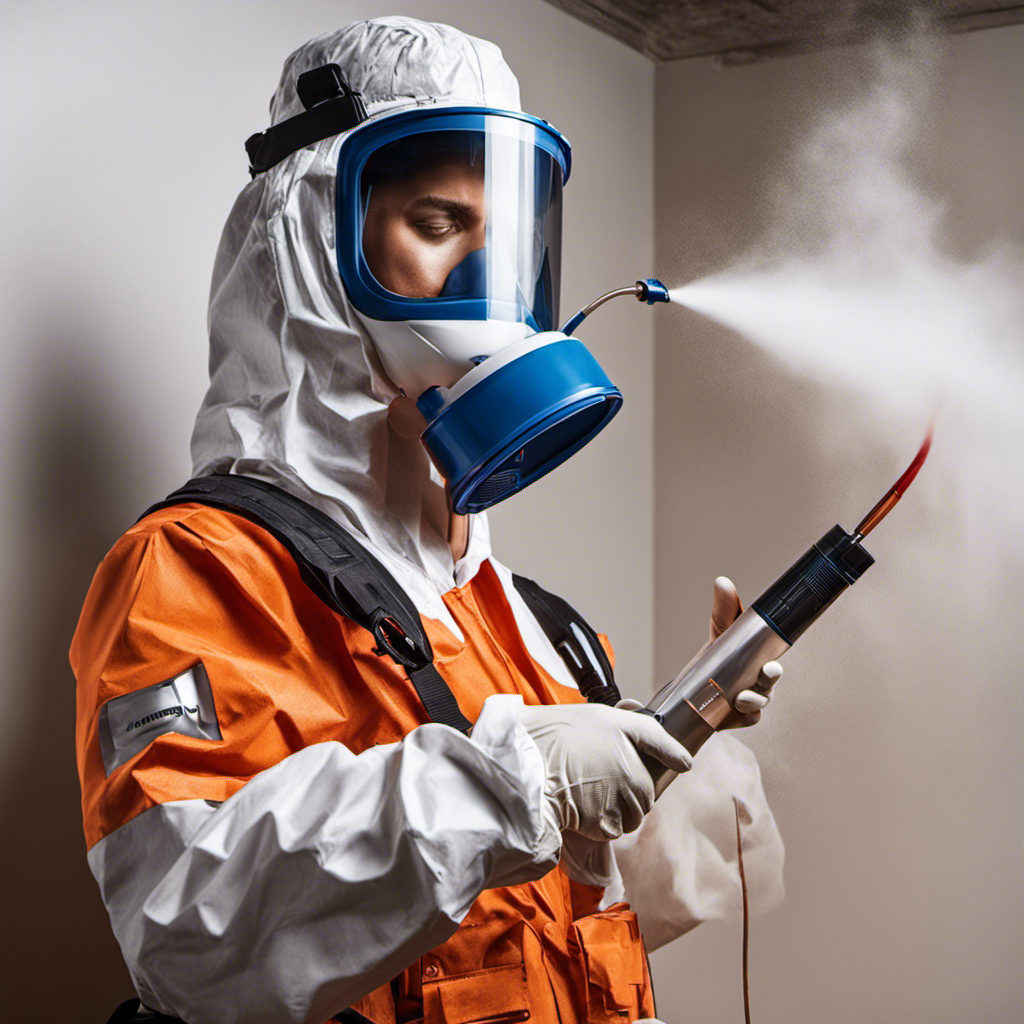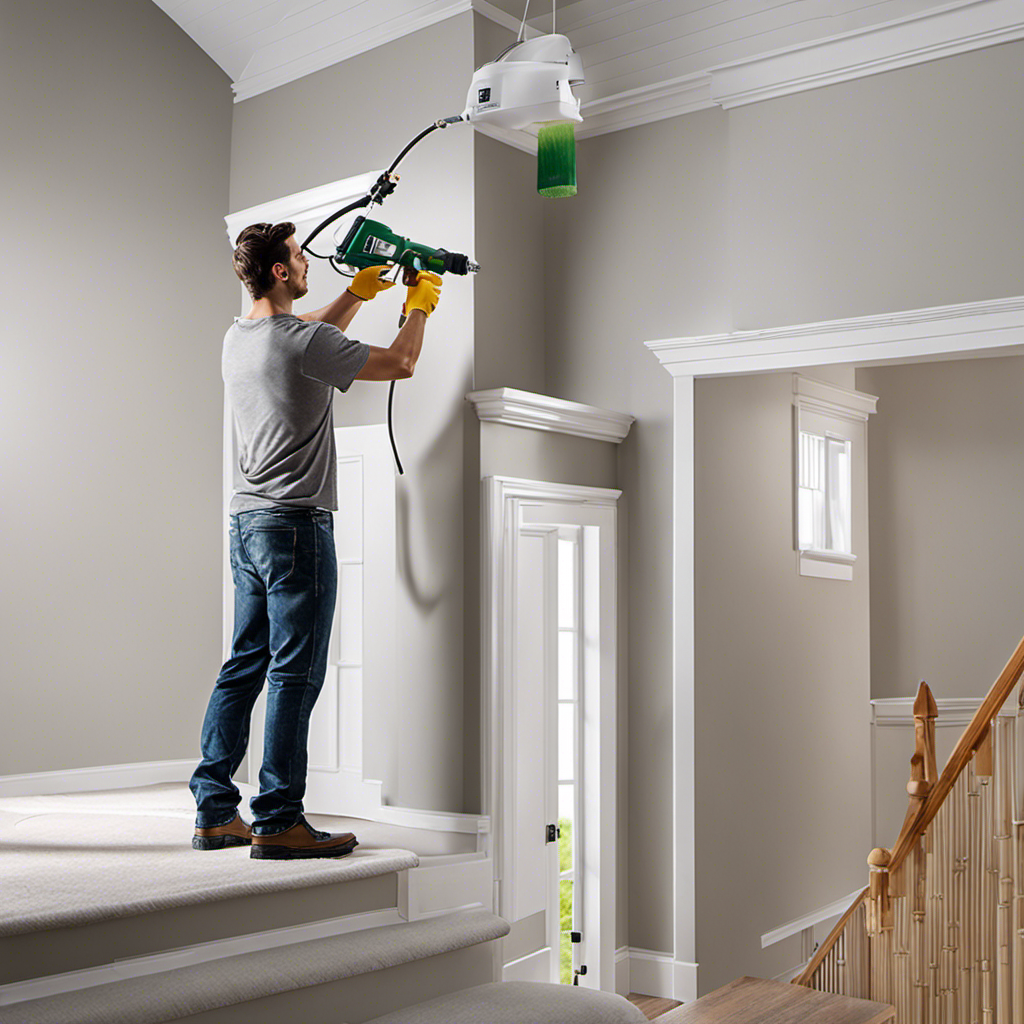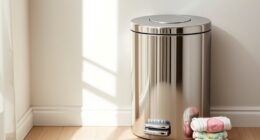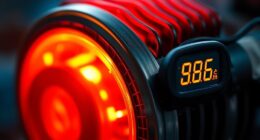In the realm of house painting, understanding the quantity of paint required and becoming proficient with an airless spray gun are key factors that can greatly impact the outcome.
In this article, you’ll discover the secrets to calculating paint needs and get valuable tips for using an airless sprayer. By measuring the surface area, factoring in the number of coats, and estimating the paint quantity, you’ll be well-prepared for your project.
And don’t forget to buy extra paint for touch-ups and consider the benefits and safety precautions of using an airless sprayer.
Let’s dive in and transform your painting experience!
Key Takeaways
- Measure the surface area of the house and subtract any areas that won’t be painted to determine the total surface area.
- Determine the paint coverage per gallon based on the type of surface and calculate the amount of paint needed.
- Research the best type of paint for the desired color options and understand the number of coats needed.
- Consider buying extra paint for future touch-ups and to allow for flexibility in color scheme changes or additions.
Determining the Surface Area
To determine the surface area of the house, the painter measures the length and height of each wall and multiplies them to get the area of each wall. This step is crucial in calculating the amount of paint needed for the project.
Accurate measurements are important to ensure that enough paint is purchased, preventing any shortages or excess. It is also necessary to adjust for wastage, as some paint may be lost during application or due to factors like spills or touch-ups.
Accounting for Number of Coats
Some paint colors or finishes may require multiple coats, so it is important to accurately estimate the amount of paint needed.
Several factors can affect the number of coats required for a paint job. The type and color of paint, as well as the texture and condition of the surface being painted, can all play a role in determining the number of coats needed. For example, lighter colors often require fewer coats than darker colors, while rough or porous surfaces may require additional coats for proper coverage.
When estimating paint quantity, it is essential to adjust for different surface types. Some surfaces may absorb more paint, while others may require less. By considering these factors and adjusting the paint quantity accordingly, one can ensure a successful and efficient paint job.
Estimating Paint Quantity
The manufacturer’s guidelines provide recommendations on how to estimate the quantity of paint needed for a project. Calculating paint waste and considering factors affecting paint coverage are essential in accurately determining the amount of paint required.
To calculate paint waste, it is important to account for any touch-ups or additional coats that may be necessary. Factors such as the type of surface being painted, its texture, and its porosity can affect paint coverage. Smooth surfaces generally require less paint than textured or porous surfaces.
It is also important to consider the number of coats needed for the desired finish. By taking these factors into account, one can estimate the quantity of paint needed for a project and ensure that there is enough paint to complete the job satisfactorily.
Buying Extra Paint for Touch-Ups
Purchasing additional paint not only ensures enough for the project, but also provides the flexibility for future touch-ups and modifications to the color scheme. Here are some benefits of buying extra paint and tips for storing leftover paint:
-
Easy Color Matching: Having extra paint on hand allows for seamless touch-ups in the future. This ensures that any repairs or modifications blend in perfectly with the original paint job.
-
Cost-Effective Repairs: By buying extra paint upfront, homeowners can avoid the hassle and cost of having to search for a matching color later on. It saves time and money in the long run.
-
Convenient Maintenance: Storing leftover paint properly ensures that it remains usable for future touch-ups. Tips for storing include sealing the paint can tightly, keeping it in a cool and dry place, and avoiding extreme temperatures.
Airless Sprayer Benefits and Tips
Using an airless sprayer allows for faster and more efficient application of paint, resulting in an even and flawless finish. The benefits of using an airless sprayer are numerous. Firstly, it significantly reduces painting time compared to traditional methods like using a brush or roller. Secondly, it provides better coverage and eliminates brush marks or roller lines. Thirdly, it reduces overspray, minimizing wastage and ensuring a more cost-effective painting process. Finally, it allows for easy application on various surfaces, including walls, ceilings, and even fences. When using an airless sprayer, there are a few best practices to keep in mind. It is important to wear the appropriate safety gear, such as goggles, gloves, and a respirator. Additionally, mastering the proper spraying technique is crucial for achieving an even coat. Regular maintenance of the sprayer is also necessary to ensure optimal performance. By following these tips and harnessing the benefits of an airless sprayer, painting projects can be completed efficiently and with professional-looking results.
| Benefits of Using an Airless Sprayer | Best Practices for Using an Airless Sprayer |
|---|---|
| Faster and more efficient painting | Wear appropriate safety gear |
| Even and flawless finish | Master proper spraying technique |
| Better coverage | Regular maintenance for optimal performance |
| Reduced overspray | |
| Easy application on various surfaces |
Safety Precautions and Maintenance for Airless Sprayers
After learning about the benefits and tips of using an airless sprayer for house painting, it is crucial to prioritize safety precautions and proper equipment maintenance. Here are three important points to keep in mind:
-
Importance of Protective Gear:
- Always wear goggles to protect your eyes from paint particles and debris.
- Gloves should be worn to shield your hands from chemicals and potential injuries.
- A respirator is essential for filtering out harmful fumes and ensuring your respiratory health.
-
Proper Equipment Maintenance:
- Regularly clean the sprayer to prevent clogs and maintain optimal performance.
- Check and replace worn or damaged parts to avoid potential malfunctions.
- Store the sprayer in a clean and dry environment to prevent rust and damage.
Frequently Asked Questions
What Are the Different Types of Paint Finishes Available?
Different types of paint finishes include matte and glossy.
Matte finishes have a flat, non-reflective appearance, making them ideal for hiding imperfections on walls.
Glossy finishes, on the other hand, have a shiny, reflective surface that adds depth and durability.
When choosing the right paint finish for different surfaces, consider factors such as the level of durability required and the amount of light the room receives.
It’s important to select a finish that complements the overall aesthetic and serves the practical needs of the space.
Can I Use the Same Type of Paint for Both Interior and Exterior Surfaces?
Yes, the same type of paint can be used for both interior and exterior surfaces. However, it is important to consider the paint durability and exterior paint color options when making this decision.
Using the same paint type ensures consistency, but different surfaces have different needs. It is recommended to research the best type of paint for each surface to ensure long-lasting results.
How Long Does It Typically Take to Paint a House Using an Airless Sprayer?
Typically, painting a house using an airless sprayer takes about 2-3 days. This timeframe includes proper surface preparation, technique, and favorable weather conditions.
To ensure optimal performance, it’s important to clean the airless sprayer properly after each use.
Common mistakes to avoid when using an airless sprayer include not using the recommended paint viscosity, failing to maintain the proper spray distance, and neglecting to cover nearby objects to prevent overspray.
What Safety Precautions Should I Take When Using an Airless Sprayer?
When using an airless sprayer, it’s important to prioritize safety. Proper safety gear, such as goggles, gloves, and a respirator, should be worn to protect against potential hazards.
It’s also crucial to master airless sprayer techniques to ensure an even coating and avoid accidents.
What Additional Tools and Equipment Are Required for Optimal Airless Sprayer Performance?
To achieve optimal airless sprayer performance, there are a few additional tools and equipment that are necessary.
These include:
- A high-quality paint sprayer
- A variety of spray tips for different surfaces and finishes
- A pressure regulator to control the flow and pressure of the paint
- A clean, dry air supply to prevent clogs and ensure smooth operation
Regular maintenance is also essential for optimal performance. This includes cleaning and lubricating the sprayer. Troubleshooting techniques, like unclogging the nozzle, are also important.
Conclusion
In conclusion, calculating the amount of paint needed for a house painting project is crucial for a successful outcome. By accurately measuring the surface area and considering factors like paint coverage per gallon and number of coats required, one can avoid running out of paint or wasting money on excess.
Additionally, buying extra paint for touch-ups is a wise investment. It’s always better to have a little extra paint on hand than to scramble to find a matching color for touch-up work later on.
Furthermore, using an airless sprayer can greatly improve efficiency. With an airless sprayer, you can cover larger areas in less time compared to using a brush or roller. However, it’s important to prioritize safety precautions and proper maintenance when using a sprayer. Make sure to wear protective gear and follow the manufacturer’s instructions for safe operation.
Just like a well-oiled machine, a properly maintained sprayer can ensure smooth and flawless painting results. Regularly clean and maintain the sprayer to prevent clogs or malfunctions that could affect the quality of the paint job. Taking the time to properly care for your equipment will pay off in the long run.
Franz came aboard the Paint Sprayer Zone team with a background in both journalism and home renovation. His articulate writing style, combined with a passion for DIY projects, makes him an invaluable asset. Franz has a knack for breaking down technical jargon into easy-to-understand content, ensuring that even the most novice of readers can grasp the complexities of paint sprayers.
